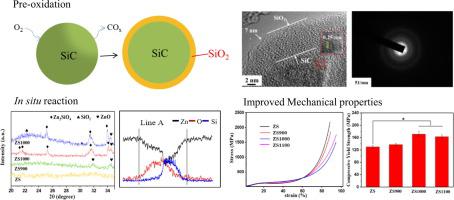Journal of Advanced Research ( IF 11.4 ) Pub Date : 2021-10-05 , DOI: 10.1016/j.jare.2021.09.014 Chengde Gao 1 , Meng Yao 1 , Shuping Peng 2, 3 , Wei Tan 4, 5 , Cijun Shuai 1, 6

|
Introduction
Nano-SiC has attracted great attention as ceramic reinforcement in metal matrix composites, but the weak interface bonding between them remains a bottleneck for efficient strengthening.
Objective
In this study, pre-oxidation treatments and selective laser melting (SLM) were employed to prepare Zn/nano-SiC biocomposites with strengthened interface bonding via in situ reaction.
Methods
Nano-SiC and Zn powders were pre-oxidized respectively, and then used to prepare Zn/nano-SiC biocomposites via SLM. The powder microstructure, and the interface characteristics and mechanical properties of the biocomposites were investigated. The degradation properties and cell response were analyzed to evaluate their feasibility for orthopedic applications.
Results
The results indicated that the pre-oxidation treatments generated a uniform oxide layer on the surface of both nano-SiC and Zn particles and the thickness of the oxide layer increased with pre-oxidation temperature. During the SLM process, the oxide layers not only improved the metal-ceramic wettability by reducing interface energy, but also induced in situ reaction to form chemical bonding between the Zn matrix and nano-SiC, thereby improving the interface bonding. Consequently, the Zn biocomposite reinforced by nano-SiC with a pre-oxidation temperature of 1000 °C (ZS1000 biocomposite) exhibited more transgranular fracture and significantly enhanced compressive yield strength of 171.5 MPa, which was 31.6% higher than that of the Zn biocomposite reinforced by nano-SiC without pre-oxidation. Moreover, the ZS1000 biocomposite presented slightly accelerated degradation which might be ascribed to the facilitated electron transfer by the interface product (Zn2SiO4). In addition, the ZS1000 biocomposite also showed appropriate biocompatibility for MG-63 cell adhesion, growth, and proliferation.
Conclusion
This study shows the potential practical applicability for the preparation of Zn-based biocomposites with strong interface bonding and mechanical properties for orthopedic applications.
中文翻译:

激光选区熔融制备的可生物降解Zn/nano-SiC复合材料的预氧化诱导原位界面强化
介绍
纳米SiC作为金属基复合材料中的陶瓷增强材料备受关注,但它们之间的弱界面结合仍然是有效增强的瓶颈。
客观的
在这项研究中,采用预氧化处理和选择性激光熔化(SLM)通过原位反应制备具有强化界面结合的 Zn/nano-SiC 生物复合材料。
方法
将纳米碳化硅和锌粉分别预氧化,然后通过SLM制备Zn/纳米-SiC生物复合材料。研究了生物复合材料的粉末微观结构、界面特征和力学性能。分析降解特性和细胞反应以评估其在骨科应用中的可行性。
结果
结果表明,预氧化处理在纳米SiC和Zn颗粒表面均产生了均匀的氧化层,氧化层的厚度随着预氧化温度的升高而增加。在 SLM 过程中,氧化层不仅通过降低界面能来提高金属-陶瓷的润湿性,而且还可以原位诱导反应使Zn基体与纳米SiC之间形成化学键,从而改善界面结合。因此,预氧化温度为 1000 ℃的纳米 SiC 增强的 Zn 生物复合材料(ZS1000 生物复合材料)表现出更多的穿晶断裂和显着提高的 171.5 MPa 的抗压屈服强度,比 Zn 生物复合材料增强的高 31.6%由未经预氧化的纳米碳化硅制成。此外,ZS1000 生物复合材料的降解速度略有加快,这可能是由于界面产物(Zn 2 SiO 4)促进了电子转移。此外,ZS1000 生物复合材料还显示出对 MG-63 细胞粘附、生长和增殖的适当生物相容性。
结论
该研究表明,制备具有强界面结合和机械性能的锌基生物复合材料在骨科应用中具有潜在的实际应用价值。











































 京公网安备 11010802027423号
京公网安备 11010802027423号